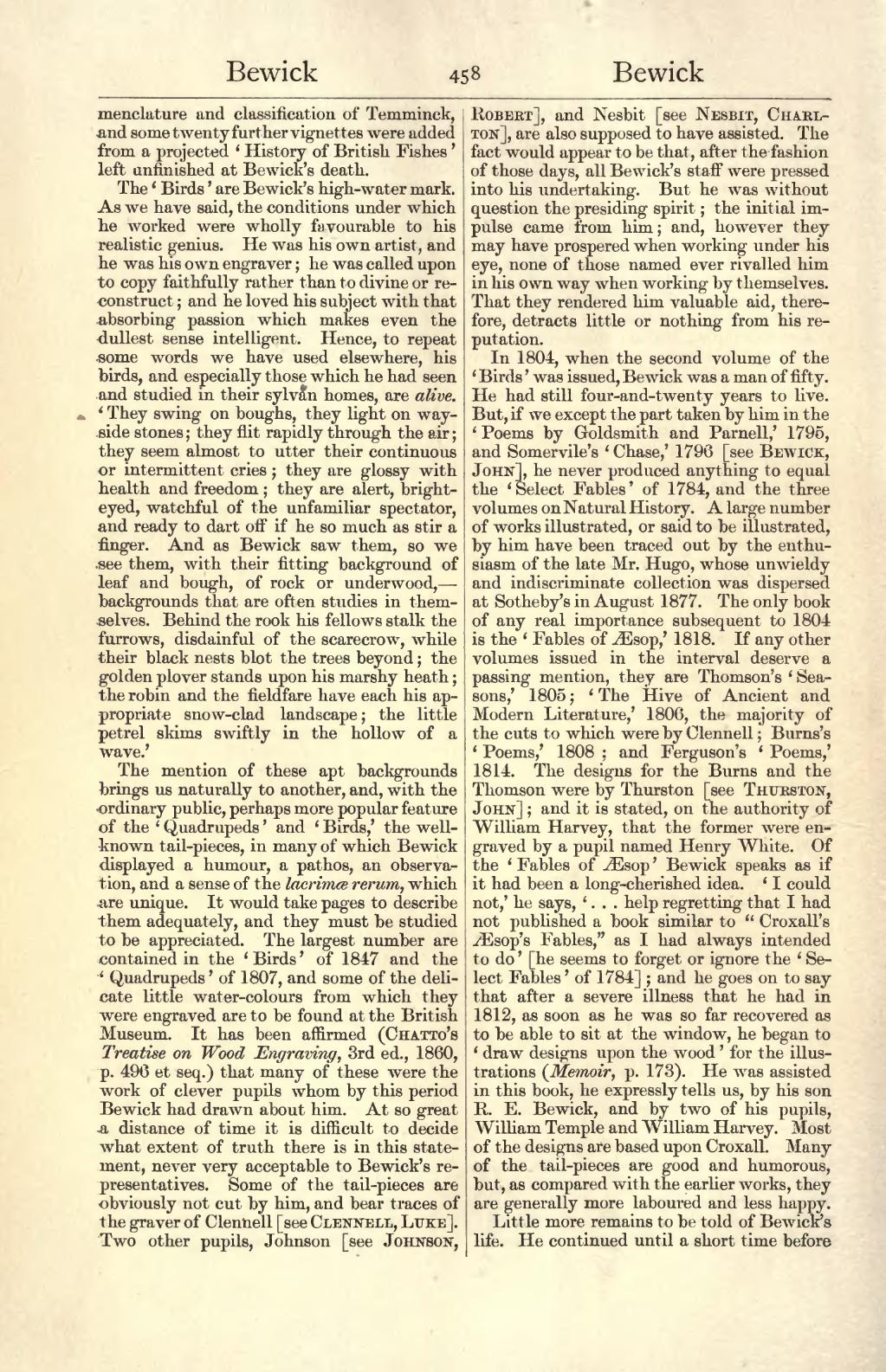menclature and classification of Temminck, and some twenty further vignettes were added from a projected 'History of British Fishes' left unfinished at Bewick's death.
The 'Birds' are Bewick's high-water mark, As we have said, the conditions under which he worked were wholly favourable to his realistic genius. He was his own artist, and he was his own engraver; he was called upon to copy faithfully rather than to divine or reconstruct; and he loved his subject with that absorbing passion which makes even the dullest sense intelligent. Hence, to repeat some words we have used elsewhere, his birds, and especially those which he had seen and studied in their sylvan homes, are alive. 'They swing on boughs, they light on wayside stones; they flit rapidly through the air; they seem almost to utter their continuous or intermittent cries; they are glossy with health and freedom; they are alert, bright-eyed, watchful of the unfamiliar spectator, and ready to dart off if he so much as stir a finger. And as Bewick saw them, so we see them, with their fitting background of leaf and bough, of rock or underwood,—backgrounds that are often studies in themselves. Behind the rook his fellows stalk the furrows, disdainful of the scarecrow, while their black nests blot the trees beyond; the golden plover stands upon his marshy heath; the robin and the fieldfare have each his appropriate snow-clad landscape; the little petrel skims swiftly in the hollow of a wave.'
The mention of these apt backgrounds brings us naturally to another, and, with the ordinary public, perhaps more popular feature of the '(Quadrupeds' and 'Birds,' the well-known tail-pieces, in many of which Bewick displayed a humour, a pathos, an observation, and a sense of the lacrimæ rerum, which are unique. It would take pages to describe them adequately, and they must be studied to be appreciated. The largest number are contained in the 'Birds' of 1847 and the ' Quadrupeds ' of 1807, and some of the delicate little water-colours from which they were engraved are to be found at the British Museum. It has been affirmed (Chatto's Treatise on Wood Engraving, 3rd ed., 1860, p. 396 et seq.) that many of these were the work of clever pupils whom by this period Bewick had drawn about him. At so great a distance of time it is difficult to decide what extent of truth there is in this statement, never very acceptable to Bewick's representatives. Some of the tail-pieces are obviously not cut by him, and bear traces of the graver of Clennell [see Clennell, Luke]. Two other pupils, Johnson [see Johnson, Robert], and Nesbit [see Nesbit, Charlton], are also supposed to have assisted. The fact would appear to be that, after the fashion of those days, all Bewick's staff were pressed into his undertaking. But he was without question the presiding spirit; the initial impulse came from him; and, however they may have prospered when working under his eye, none of those named ever rivalled him in his own way when working by themselves. That they rendered him valuable aid, therefore, detracts little or nothing from his reputation.
In 1804, when the second volume of the 'Birds' was issued, Bewick was a man of fifty, He had still four-and-twenty years to live. But, if we except the part taken by him in the 'Poems by Groldsmith and Parnell,' 1795, and Somervile's 'Chase,' 1796 [see Bewick, John], he never produced anything to equal the 'Select Fables' of 1784, and the three volumes on Natural History. A large number of works illustrated, or said to be illustrated, by him have been traced out by the enthusiasm of the late Mr. Hugo, whose unwieldy and indiscriminate collection was dispersed at Sotheby's in August 1877. The only book of any real importance subsequent to 1804 is the 'Fables of ÆEsop,' 1818. If any other volumes issued in the interval deserve a passing mention, they are Thomson's 'Seasons,' 1805; 'The Hive of Ancient and Modern Literature,' 1806, the majority of the cuts to which were by Clennell: Burns's 'Poems,' 1808: and Ferguson's 'Poems,' 1814. The designs for the Burns and the Thomson were by Thurston [see Thurston, John]: and it is stated, on the authority of William Harvey, that the former were engraved by a pupil named Henry White. Of the 'Fables of Æsop' Bewick speaks as if it had been a long-cherished idea. 'I could not,' he says, '… help regretting that I had not published a book similar to "Croxall's Æsop's Fables," as I had always intended to do' he seems to forget or ignore the 'Select Fables' of 1784; and he goes on to say that after a severe illness that he had in 1812, as soon as he was so far recovered as to be able to sit at the window, he began to 'draw designs upon the wood' for the illustrations (Memoir, p. 173). He was assisted in this book, he expressly tells us, by his son R. E. Bewick, and by two of his pupils, William Temple and William Harvey. Most of the designs are based upon Croxall. Many of the tail-pieces are good and humorous, but, as compared with the earlier works, they are generally more laboured and less happy.
Little more remains to be told of Bewick's life. He continued until a short time before
